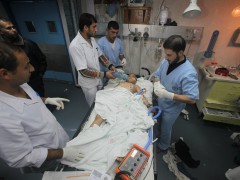No Development and Peace Without Health

For a long time, development indicators have been linked with two important elements: the first is health, and the second is environmental health. Both of these are related to the social structure which is the basis for the development process. Furthermore, human development is, significantly linked to the planning and organizational principles of resources and economic benefits. So if we want to measure the degree of development in any society, we must look at its health indicators which paint a clear, if incomplete, picture of how that society is faring. Health, healthcare system, environmental health and society are all integrated parts that affect the prospects for economic development.
On many occasions the United Nations has emphasized that sustainable human development is a process of empowering human, economic and social development, saving natural resources and maintaining the development process – in all its economic, social, political and environmental aspects – built around the concept of equality. According to the Global Competitiveness Report by the World Economic Forum, there are twelve pillars which define the increment of economic competitiveness. Health and primary education are among these. Healthy people, workers and professionals are important for a country’s competitiveness and productivity. The more people get sick, the higher the health costs will be. When professionals fall sick, production goes down. Poor health most definitely leads to significant costs for business and the public purse which impact on economic development.
However, we Palestinians have a different story to tell. Our health system and services are unlike those of any other society’s on the globe given the sheer diversity of healthcare providers, the political situation, the high level of literacy on health issues, the huge numbers of children and women, the vulnerable economic situation and the siege imposed on the Palestinian territories. In the Palestinian territories (West Bank, Gaza strip and Jerusalem), healthcare is provided by two main organizations. The first is the United Nations Relief and the Works Agency for Palestine Refugees (UNRWA), and the second is the Palestinian Authority represented by the ministry of health. Palestinian refugees registered with UNRWA are entitled to receive healthcare from UNRWA and governmental departments. However, those Palestinians who are not registered as refugees can receive their healthcare services only from government hospitals and medical centres. In recent years, Gaza has been isolated from the rest of the world, with no room for delivering proper healthcare to the people. In the West Bank, it makes no difference, except in terms of the easier import of medicine. However, as development is always linked to healthcare, so is peace also related to healthcare.
Health statistics show that healthcare in the Palestinian territories is hardly sufficient to keep people alive. For example, women in Palestine (Gaza, West Bank and Jerusalem) have a 70% risk of death from breast cancer, while Israeli women have a 70% chance of survival. Many factors have contributed to this dangerous situation, but the principal one is the Israeli occupation. Access to healthcare in the West Bank is restricted by over 100 military checkpoints, over 400 roadblocks, and a 723 km long separation wall which cuts off dozens of villages from healthcare centres.
The World Health Organization has identified severe cases of malnutrition in Gaza. Since 2005, Israel has calculated how many calories would be needed to avert a humanitarian disaster in the impoverished Palestinian territory. Besides that, curfews, high rate of unemployment and food insecurity are challenges for all international relief organizations, the UN and the Palestinian Authorities. In the Gaza strip, the situation got worse after Israel imposed a blockade on certain types of medicines. This contributed to the death of more than 250 people. The shortage of antibiotics, aspirin and other crucial medical facilities, such as kidney cleaning machines, increases the suffering of Palestinians. The shortage has forced many people to ask for permission from the Israeli army in order to be granted access to healthcare centres in Israel or Jordan; others have left for Egypt too. Despite the large number of applications, however, it is rare that Palestinians are allowed to travel for medical treatment. Moreover, Palestinian doctors have few opportunities in the Palestinian territories. There are no opportunities for them to develop their skills and continue training as specialists. And with the brain drain to Europe and North America, there is a chronic shortage of specialists in serious illness and diseases.
Palestinians face enormous obstacles in their struggle for better healthcare. Access to mental and physical health is deteriorating, and unless Israel leaves the territories – so that Palestinian and international organization can finally begin to implement sustainable healthcare and no longer be dependent on emergency relief – there is no hope on the horizon. Palestinians are suffering under the occupation and the impossibility to access proper health care, and have no room for development or peace.
Healthcare is not only necessary for economic growth, it is also necessary for peace. The economy needs peace and stability to grow and develop. What does that mean? For me, as a Palestinian, it means that I must be healthy enough to think about peace before development and economic growth. The question should be how peace and stability can make us healthier. At least in Palestine!
Tags: cancer, Gaza, health care, Israel, middle east, Palestine, public health

